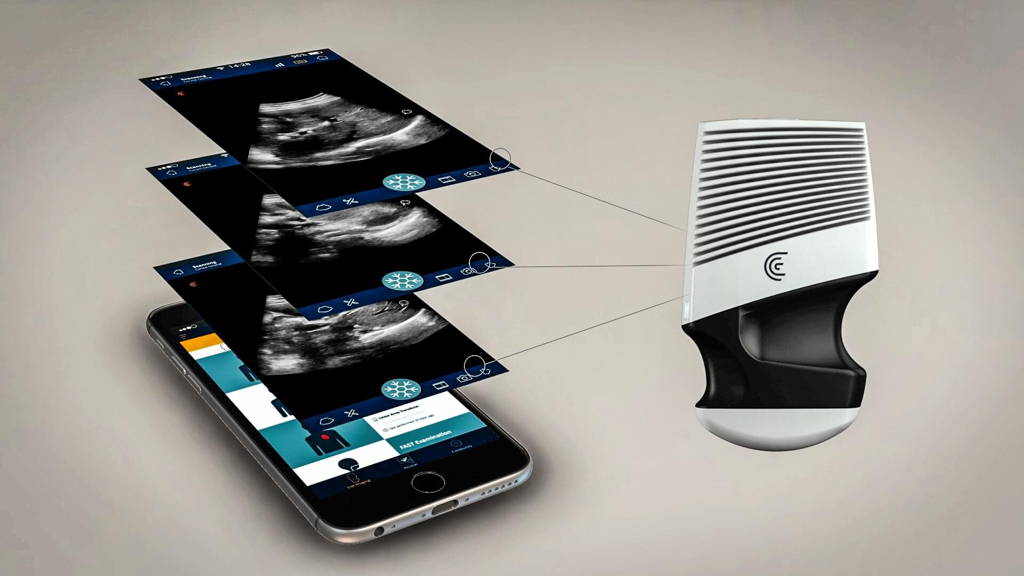The ultrasound market is a $6 billion global industry. The use of ultrasounds for women's health and pregnancy follow-ups represents less than 20% of the overall use for healthcare. Diagnostic ultrasound is routinely used to diagnose an assortment of healthcare conditions such as cancer, gall stones, and cardiovascular diseases. Ultrasounds are also a more trusted tool for examination amongst clinicians, because they provide a clear, real-time glimpse into the human body without the potential of radiation harming the body as experienced with x-rays. Further, ultrasounds eliminate delays in diagnosis that result from traditional x-ray processes.
The lower risk and increased efficiency is not without cost, literally. Many clinicians don’t use ultrasound but instead perform blind procedures due to cost barriers and ease of use. As medical technology continues evolving at a rapid pace, doctors are faced with the challenge of adapting, or remaining reliant upon methods that prove more expensive, inefficient and potentially harmful to patients.
The startup was developed by a trained collective of experienced innovators who have played an instrumental role in reshaping the ultrasound industry. Their team of developers were the brains behind the first PC-based platform for ultrasound research. Additionally, Clarius Mobile Health introduced the first touch screen ultrasound system with a simplified user interface, Forbes writes (ultrasound imaging).
Clarius ultrasound scanners are categorized as a “Point of Care” ultrasound, says Pellier, which currently represents approximately 15% of the overall $6B global ultrasound market. “As ultrasound systems for point of care become lighter, more accessible, and easier to use (e.g: "point and shoot"), their adoption will increase, which will improve patient care because physicians are able to make better decisions when they can immediately see what is going on inside the body.
More and more medical schools are teaching ultrasound as a matter of course, because affordable systems like ours make it easier to implement ultrasound programs. Eventually, we believe every doctor will own a handheld ultrasound that they will use in daily practice, just like a visual stethoscope.”
The digital health industry is at a crossroads where rapid progress in consumer technology is facilitating significant efficiencies in the development of medical device and health IT technologies, Pellier believes. Whether through miniaturization, ease of use, or connectivity -- companies are leveraging mainstream technology to improve the way healthcare is delivered.
“The healthcare landscape is slow to change for a variety of reasons. But, as disruptive companies like Clarius develop tools that are designed to improve healthcare and reduce costs, their adoption is inevitable. Patients are more informed than ever and they will demand more from their caregivers.”
The lower risk and increased efficiency is not without cost, literally. Many clinicians don’t use ultrasound but instead perform blind procedures due to cost barriers and ease of use. As medical technology continues evolving at a rapid pace, doctors are faced with the challenge of adapting, or remaining reliant upon methods that prove more expensive, inefficient and potentially harmful to patients.
Merging mobile phones, technology & ultrasound experience
Founded in 2014 by Laurent Pelissier, Clarius Mobile Health now merges the power of mobile phones, advanced technology, and decades of collective ultrasound experience to produce a high quality, point-and-shoot ultrasound device compatible with virtually any smart device. The technology is easy to operate, using the same functionality as touch screen smart devices, with the majority of controls being automated. Allowing clinicians to keep an ultrasound system in their pockets has led to a heightened adoption rate and expedited care times.The startup was developed by a trained collective of experienced innovators who have played an instrumental role in reshaping the ultrasound industry. Their team of developers were the brains behind the first PC-based platform for ultrasound research. Additionally, Clarius Mobile Health introduced the first touch screen ultrasound system with a simplified user interface, Forbes writes (ultrasound imaging).
Affordable, portable ultrasound imaging
According to Laurent Pelissier, ultrasound is a safe and easy way to see inside a patient’s body. Over the past 15 years, due to miniaturization of ultrasound technology, which has made it more affordable and portable, ultrasound imaging has made its way to the point of patient care. Ultrasounds are now widely used to triage trauma patients in emergency situations, and to provide image guidance when performing procedures such as biopsies and regional anesthesia. Since patient anatomy varies, an ultrasound allows the physician to see under the skin to guide their needle to exactly the right area.Clarius ultrasound scanners are categorized as a “Point of Care” ultrasound, says Pellier, which currently represents approximately 15% of the overall $6B global ultrasound market. “As ultrasound systems for point of care become lighter, more accessible, and easier to use (e.g: "point and shoot"), their adoption will increase, which will improve patient care because physicians are able to make better decisions when they can immediately see what is going on inside the body.
More and more medical schools are teaching ultrasound as a matter of course, because affordable systems like ours make it easier to implement ultrasound programs. Eventually, we believe every doctor will own a handheld ultrasound that they will use in daily practice, just like a visual stethoscope.”
The digital health industry is at a crossroads where rapid progress in consumer technology is facilitating significant efficiencies in the development of medical device and health IT technologies, Pellier believes. Whether through miniaturization, ease of use, or connectivity -- companies are leveraging mainstream technology to improve the way healthcare is delivered.
“The healthcare landscape is slow to change for a variety of reasons. But, as disruptive companies like Clarius develop tools that are designed to improve healthcare and reduce costs, their adoption is inevitable. Patients are more informed than ever and they will demand more from their caregivers.”






